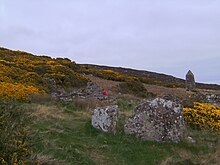User:Richerman/Sandbox

Badbea (pronounced bad-bay) is a ruined clearance village perched on the cliff tops of the east coast of Caithness, Scotland, approximately five miles north of Helmsdale. The village was settled in the eighteenth and nineteenth centuries by families evicted from their homes when the straths of Langwell, Ousdale and Berriedale were cleared for the establishment of sheep farms. The last resident left the village in 1911 and a monument was erected by the son of former inhabitant, Alexander Robert Sutherland, who had emigrated to New Zealand in 1839. Today, the ruins of the village are preserved as a tourist attraction and memorial to the Scottish clearances.
History[edit]

Toward the end of the 18th century tenant farmers were being evicted from their homes across the Scottish highlands to make way for sheep farming. From 1792 onwards displaced families began to arrive in Badbea, a small area of rough, steeply sloping land squeezed between the high drystone wall of the sheep enclosures and the precipitous cliffs of Berriedale above the North Sea. Many of the families were from nearby Ousdale, where landowner Sir John Sinclair of Ulbster had evicted them from their crofts in order to introduce sheep. Others came from the villages of Kildonan and Auchencraig.[1] When the families arrived they were given small plots to farm but had to clear the land, hack out the plots from the steep slopes and build their their own houses from the stones they found. [1][2] At its height there were 28 families living in the village, but during the 19th century the herring fishing was stopped by the landowner and the population declined, with many of the families emigrating to the USA or New Zealand to seek a better life. The last inhabitant left the village in 1911, and in that year David Sutherland, the son of one of the New Zealnd emigrants Alexander Robert Sutherland, erected a monument on the site in memory of his father and the people of Badbea.[3][4]
Daily life[edit]
The plots of land or crofts, had room for a longhouse with a byre at one end, outbuildings and a Kitchen garden or kailyard. The rest of the available land could only support some small vegetable plots and a few cows, pigs and chickens for each family.[2][3] Fresh water came from a nearby spring. There was only one horse in the village and no plough, so a chaib (a kind of spade) was used to plough the soil and the harrow was pulled by a man.[3] Each house had its own spinning wheel and all the women learnt spinning and carding. The men mainly worked as herring fishermen from nearby Berriedale and the women gutted the fish that had been caught. While the women were working the livestock, and even the children, were tethered to rocks or posts to stop them being blown over the cliffs or into the sea by the fierce winds.[3][2]
References[edit]

- ^ a b Drainey, Nick (3 May 2009). "Walk of the week: Badbea Clearance Village, Caithness". LIVING. Scotsman.com. Johnston Press Digital Publishing. Retrieved 19 may 2009.
{{cite web}}: Check date values in:|accessdate=(help) - ^ a b c Horton, Mark. "British Isles Coast Gallery: Badbea". BBC History. BBC. Retrieved 20 June 2009.
- ^ a b c d Anon. "The Badbea Settlement". The Highland Clearances. Cauldeen Primary School. Retrieved 19 June 2009.
- ^ Inscription on the Badbea monument
